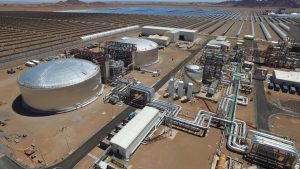Gonzalo Martín, General Secretary of Protermosolar, will analyze what the role of concentrated solar power plants will be in energy storage within a decade at the I Energy Storage Congress (ALEN’20).
Currently, thermal storage in molten salts in solar thermal power plants reaches 7 GWhe in Spain.

This type of storage can perform two main functions: to generate energy in the evening and at night in a complementary way to photovoltaic production and as a strategic energy reserve when the system needs it.
ALEN’20, with the sponsorship of Protermosolar, will take place on October 21 and 22.
Protermosolar participates in the first Energy Storage Congress (ALEN’20), organized by the Energy Foundation of the Community of Madrid together with the Higher Technical School of Mining and Energy Engineers and the sponsorship of Protermosolar, which will be held on October 21 and 22 electronically. At the event, the general secretary of Protermosolar, Gonzalo Martín, will analyze the role of concentrating solar power in energy storage within a decade.
Protermosolar defends the use of thermal storage in molten salts in solar thermal plants (TES) as it is a commercial and mature solution, with more than a decade of operation in Spain at a very competitive cost. This type of storage can perform two main functions: generate energy in a complementary way to photovoltaic at night hours and as a strategic energy reserve when the system needs it.
For Gonzalo Martín, general secretary of Protermosolar, “it makes perfect sense to defend storage solutions that separate delivery capture, since facilities that only extend their generation for a couple of hours compete with their counterparts without storage, but are more expensive.”
Currently, thermal storage in molten salts in solar thermal plants reaches 7 GWhe in Spain and with the existing solar thermal plants that could install this system it is easily expandable to 12 GWhe. If the PNIEC (National Integrated Energy and Climate Plan) is complied with, solar thermal energy could contribute more than 60 GWhe of storage capacity to the system.
“It is necessary to recognize the current thermal storage capacity in molten salts in the solar thermal plants in Spain and put it in value before the risk that certain storage business models are not attractive if certain hypotheses are not fulfilled, such as the planned interconnections , that more nuclear power plants were kept in operation or that photovoltaic technology did not reach its penetration objectives, and as a result of all this, price arbitrage was not attractive for new storage investments «, explains Gonzalo Martín, general secretary of Protermosolar , which adds: “thermal storage will work in a completely complementary way to photovoltaics, capturing energy during the day, but dispatching it in the evening. This has several advantages, such as not cannibalizing the daytime price, mitigating the ‘duck curve’ at dusk, and providing firm, 100% renewable night backup capacity. ”
This I Energy Storage Congress (ALEN’20) was created with the objective of providing an overview of the different energy storage systems through the experience and vision of its speakers, their applications and their possibilities for future development. The development of renewable energies constitutes one of the main points in the energy policy in Spain, marked by the need to reduce energy dependence from abroad, as well as to reduce carbon emissions and to comply with the environmental and efficiency commitments contracted.


